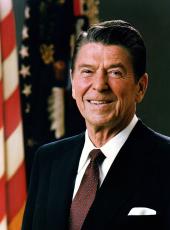
Remarks on Presenting the 1982 Awards of the HUD National Recognition Program for Community Development Partnerships
Well, I'm here, first, to congratulate all of you. And it's a true pleasure to welcome you here to pay tribute to you and the public and the private sector leaders who've displayed so much creativity, initiative, and tenacity in forging successful public-private partnerships in communities across the country.
And the idea that local government and private sectors should work in harmony in tackling serious problems is about as old as our Republic. But somewhere along the line, in recent years, the people began looking to Washington as the solution to the problems. And after decades of relying on Federal solutions, I think the people are beginning to notice that many of the problems are not only still with us, but, in some cases, they're getting worse.
When we got here, almost 2 years ago now, we promised that we would do our best to bring resources and responsibilities back to the people, to levels of government that were closer to them and more responsive to their needs. Today we're recognizing the program which activates the community forces that are most efficient at meeting local needs—local government and private sector links of leaders who best know the locale, the personalities, and the standards in the area. And while the Federal Government is playing an important role, it is not the dominant partner—as has been the case far too often in the past.
There are those, of course, who are suspicious of this approach. They honestly believe that community-centered programs can't work unless the heavy Federal hand is involved. Well, that's just another way of saying that there are folks here in Washington who have some kind of monopoly on talent and compassion. And while we recognize the Federal Government has many fine people, so does local government and the private sector. And they've been sitting on the bench too long. It's time not only to get them into the game but to recognize they're really—maybe I should be putting that, you're really the first string.
We've found that in towns and cities across the country, there are hundreds of examples of local people—government, business, community activists—who are getting together, agreeing on a course of action, and then moving forward to solve long-festering problems. It's almost like the description of America that was left us by Alexis de Tocqueville, that young man, philosopher from France, who visited America 150 years ago and chronicled his observations in the classic book, "Democracy in America." He said, "Towns are like great meeting houses with all the inhabitants as members. In them the people wield immense influence over their magistrates and often carry their desires into execution without intermediaries."
Well, that's the kind of spirit that we want to encourage, and I think it's the kind of spirit that you represent. You've demonstrated that there is no such thing as "it can't be done." That was shown in Ohio, where a county lost a traditional employment base and, instead of giving up, formed its own economic development team to stimulate new commercial and industrial activity. Another project linked two major tourist attractions by eliminating a shabby and deteriorated three-block corridor that separated them. This resulted in one of the Southwest's finest commercial districts. Still another project in a metropolitan area used a block grant and private funds to make the rehabilitation of multifamily apartment buildings attractive to owners, thus expanding the housing available to low- and moderate-income families.
Today we're recognizing the most noteworthy public-private partnerships, to thank you for what you've done and to encourage others to follow your example. The projects chosen for top honors are: Savannah, Georgia's Victorian District Project; Wichita, Kansas' Elks Training Center for the Handicapped; Louisville, Kentucky's Galleria Project; Bolivar County, Mississippi's Industrial Development Project; Pascagoula, Mississippi's Adventure Island Playground; New York City's Participation Loan Program; New York's South Bronx 200 [2000] Local Development Corporation; Schenectady, New York's Canal Square; Columbus, Ohio's Innovative Grant Program; Scioto County, Ohio's Economic Development Corporation; and San Antonio, Texas' Alamo Plaza River Linkage Project.
You know, I can't help but add here—and this one isn't one that's getting recognition-I've read all of those so far that are recognized here today. But I got a letter the other day from a man—you don't very often hear a man say nice things about his brother-in-law. But this man wrote to tell me that in a little town in Illinois, where the principal source of employment, a factory, had closed. Rather than take it lying down, his brother-in-law, one of the employees who'd worked nowhere else as an adult but at that factory, collected some of the other employees, and they just started scrounging, and they got permission to take over an old building from an elderly lady who had inherited it in an estate. They scrounged around buying secondhand machinery and so forth, and they now have a successful metal-processing plant owned by these former employees of the factory that couldn't make it and went broke.
Well, this is just a sample of what's happening. And congratulations to all of you, and thank you for letting me play a part here today. It brightens my day.
Thank you.
Note: The President spoke at 2:36 p.m. in the Indian Treaty Room at the Old Executive Office Building. Following his remarks, he presented the awards to the public and private sector officials involved in the 11 projects.
Ronald Reagan, Remarks on Presenting the 1982 Awards of the HUD National Recognition Program for Community Development Partnerships Online by Gerhard Peters and John T. Woolley, The American Presidency Project https://www.presidency.ucsb.edu/node/244661

